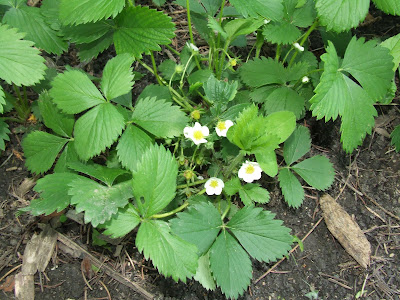 |
| Honey Bee on Oregano |
When it comes to gardening, whether fruits & veggies or flowers, there is always a fine line to walk when it comes to insects. Insects are an invaluable part of flower pollination and fruit/seed production, but often times the larval stage(s) and sometimes adults can be devastating to a garden or a specific plant.
 |
| Cabbage Butterfly laying eggs on kohlrabi. |
I have been reminded of this fact by the cabbage butterflies that are all over my yard and garden right now. This white butterfly lays its eggs on the kohl family of plants (broccoli, cabbage, cauliflower,
kohlrabi) and the little green larvae (caterpillar/worm - whatever you want to call it!) that hatch will happily eat their way through your plants. On the other hand, those same butterflies spend a lot of time flitting around my herb garden, especially the
oregano, for their own meal. If I wanted to harvest oregano seed those butterflies would be as much a friend as I feel like they are a foe in my kohls.
 |
| White-lined Sphinx Hummingbird Moth |

Another example of this dilemma was brought to my attention this weekend by an unexpected visitor. A huge (about 2 inches in length) hummingbird looking moth landed on my eldest's shoe Saturday evening. We quickly grabbed a camera and snapped a couple of pictures before it took off and disappeared around the corner of the house. I then hit the internet and a few minutes of research resulted with the identification of the
White-lined Sphinx Hummingbird Moth (Hyles lineata).
I have never seen this insect before, but apparently it is found across the continental US and into Canada & Mexico. It can have a wing span of up to about 4 inches across and is seen mostly in the dawn and dusk hours of the day around white and light colored funnel shaped flowers (like petunias). The larvae for this large moth is equally large and can be found munching on a number of different varieties of flowers or even some garden plants like tomatoes. Now tell me, if you found a
large horned caterpillar eating up your tomato plants or prized flowers would you call this creature a friend or foe?
 |
| Hornet eating a cabbage 'worm'! |
Then again on Monday another dimention of this dilemma was demonstrated to me as I watched a hornet stalking my kohls. Over the weekend, my Dad had told me how he had watched a hornet devour a cabbage 'worm' in their garden so I kept a close eye on this carnivorous predictor. Sure enough with in a few minutes he had collected a 1/4 - 1/2 inch worm and sat down to enjoy a wiggly meal. Typically I am no fan of these insects, but I will happily share my garden with a cabbage worm predictor! Eat heartily my friend for there are LOTS to be found in my
kohlrabi & cabbage right now!
Fortunately, I haven't found any extremely large horned caterpillars in my tomatoes and I have no problem squishing the cabbage 'worms' I find on my kohls, or even better, letting the hornets have them, but I have gotten to spend some time thinking about the relationship between pollinators and 'pests'.
Next time you visit your garden and watch the insects that inhabit it, ask them 'Are you a friend or foe?' and see if you get the same mixed answer I am getting. :}
Happy Gardening! :)
































